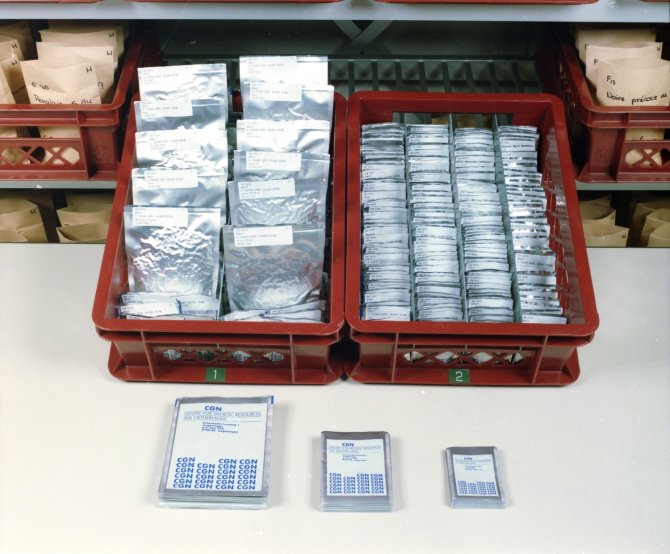By using only a handful of crops and breeds, agriculture has become vulnerable to diseases and plagues. That is why WUR is spotlighting agrobiodiversity at the UN's biodiversity conference this October. Diversity can improve resilience, whether it's in crops and animals, or farming methods themselves.
The United Nations (UN) Food and Agriculture Organisation (FAO) reported as early as the nineties that seventy-five per cent of all our food originates from just seventeen species of plants and animals. In many cases, these crops and animals are farmed intensively, which means that farmers create perfect conditions using fertilisers, pesticides, irrigation, andfeed to optimise yields. 'Primeval species have been bred into very specific types of plants and animals that are "coddled" by intensive farming methods', says Theo van Hintum, head of plant genetic resources at Centre for Genetic Resources, the Netherlands (CGN). 'This causes risks.'
'Lack of biodiversity makes agrosystems vulnerable, just as it does ecosystems', Van Hintum argues. When a species appears vulnerable to a new disease or plague, a large section of our food production system may be impacted. In fact, all it takes is one link in the chain to malfunction. Hence, Wageningen University & Research focuses on agrobiodiversity during the coming UN global diversity summit COP 16 in Colombia.
Agrobiodiversity in crops and cattle
Theo van Hintum is responsible for the storage of just under 24,000 plant varieties in CGN's gene bank. CGN is part of WUR and is commissioned by the Dutch government to conserve genetic resources. 'Our gene banks' cryo-chambers keep genetic variations of key agriculture and horticulture crops safe so that breeders can use them to develop new varieties and for scientific research', Van Hintum explains. 'Commercial varieties, old farmers' varieties and wild varieties have all been gathered. An old variety may be resistant to certain plagues and diseases.'

'Breeding has dramatically increased production values but has caused agriculture to become gradually more homogenous and intensive to cultivate the most productive varieties', says Van Hintum. As a result, agriculture has become more vulnerable. A similar trend is seen in cattle, according to CGN's director Sipke Joost Hiemstra. 'There are several bovine breeds native to the Netherlands. They are a rare occurrence now and have almost completely been replaced by breeds that produce more milk or meat', Hiemstra states. 'I call these high-production breeds elite athletes. They are specialists. When properly cared for, they can achieve excellence, but they are also more vulnerable to adversities.''
The Groninger blaarkop is such arare Dutch breed. The bovine has a white head with the exception of two large spots around the eyes. 'Extensive farmers are interested in this breed because the animals are robust and produce both milk and meat.'
Climate change drives genetic erosion
Breeding expert Peter Bourke stresses that the seeds in the gene bank are more than just a resource. 'My previous position at a foundation which conserved heritage breeds puts CGN's work in a broader perspective.' Factors that form a threat to biodiversity in general now also threaten farm crops and wild varieties. Heat, drought, soil degradation and the increase of farming soils may cause age-old varieties to disappear. 'We call this genetic erosion. Some varieties have already been lost, and more are expected to follow.'
We must seek new methods to increase resilience within our farming systems
This, while a wide variety of breeds, is extremely important. 'A large portion of our food supply is currently vulnerable to the same plagues. Apple scab, for example, disfigures apples, reduces their shelf-life, as well as causing black spots on the fruit. Supermarkets generally reject these apples. Farmers respond by using fungicides.' Bourke explains that the solution lies not just in breeding resistant apples but also in increasing the diversity of fruits we grow. 'So that we no longer depend on just a few breeds and varieties.'
Diversity in farming methods
Agrobiodiversity does not just mean diversifying crops, but also farming methods. 'Diversity in varieties implies diversifying farming methods, as different varieties require different farming practices', Bourke explains. 'Farmers transition from intensive farming to biodiversity-positive methods that create room for the environment but are also more diverse in themselves.' Examples include strip cropping and mixed cropping, where different crops are grown in close proximity, and mixed farms, where crops and cattle complement each other.
- Unfortunately, your cookie settings do not allow videos to be displayed. - check your settings
Can researchers and breeders support each other to develop biodiversity-positive food systems?
'We must seek new methods to increase resilience within our farming systems', CGN director Hiemstra argues. 'Internal resistance which utilises the biodiversity in the system itself. We must seek a larger variety of breeds that match our systems.' CGN's enormous collection of genetic resources will play a pivotal role in this search. Or, as one of the researchers puts it: 'We must keep our options open. And these options are found in our gene bank.'
Biodiversity-positive farming methods
The scientists are aware that there are obstacles on the path to increased agrobiodiversity. Economic factors, for one, says Van Hintum. 'On the one hand, a few large companies determine the supply. On the other hand, consumers must be willing to make a change. Is there a demand for more variety? Are consumers willing to pay? Can we accept a supply that changes regularly and is far less homogenous than the current supply?' Van Hintum sees markets changing but stresses that these changes are often seen in niche markets. 'Beer made from locally sourced barley, for example, and the bread culture.'
'Upscaling biodiversity-positive agriculture will take us forward towards more agrobiodiverse agriculture', Bourke states. 'To this end, existing businesses must transition, and a new generation of farmers must pick up new farming methods. This is, in fact, already happening, which is very inspiring. As scientists, we can support this transition by researching what varieties these new systems need.'






